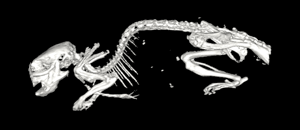Scientists have long been puzzled that mutations in dystrophin (Dmd), a sex-linked gene that is mutated in humans with Duchenne muscular dystrophy (DMD), does not cause as severe a disease in mice as it does in humans. In humans, DMD is devastating. It affects mostly males two to six years old, initially weakening the hips, pelvis, thighs and shoulders and usually progressing to total paralysis and death by age 30 (Muscular Dystrophy Association). In contrast, in mice, DMD generally causes only mild skeletal muscle defects. A research group led by Helen Blau, Ph.D., from the Stanford University School of Medicine, Stanford, Calif., may have solved this enigma. Their research has led them to conclude that DMD is more severe in humans because the relatively short telomeres of human chromosomes limit the regenerative capacity of human muscle stem cells (MuSCs), curtailing their ability to keep replicating and repairing the continual muscle damage induced by dystrophin mutations (Sacco et al. 2010).
Dystrophin, DMD, and telomeres
The dystrophin protein stabilizes skeletal muscle cell membranes. Without it, muscle fibers are fragile and injure easily, even when mildly stressed. When muscles are damaged, MuSCs proliferate, differentiate and replace the damaged fibers. More than 20 years ago, research by Blau and her colleagues led them to hypothesize that DMD MuSCs have to replicate so much to repair injured muscle that they eventually lose their regenerative capacity. Since then, numerous studies by Blau and others have supported this hypothesis and suggested that MuSCs lose their regenerative capacity due to telomere shortening. In fact, one study reported that the telomeres of people with DMD are 14 times shorter than those of healthy people.
Telomeres are DNA repeats on chromosome ends. One of their functions is to ensure that cells replicate properly. With every cell replication, telomeres shorten but are partially restored by DNA repeats added by the enzyme telomerase. However, as high cell-turnover tissues (like the skin, liver, kidneys and testes) age, telomere replacement does not keep up with shortening, leading to replicative senescence.
Human telomeres are shorter than those of mice (5-15 vs. > 40 kilobases). Long telomeres have been associated with lack of symptoms in mouse models of several human diseases, including Werner and ataxia-telangiectasia syndromes. Blau and her colleagues suspected that long telomeres endow mouse MuSCs with a prolonged regenerative capacity, which would explain why dystrophin-deficient mice experience only a mild DMD phenotype. To test this hypothesis, Blau and her team analyzed DMD pathogenesis in a mouse that is both dystrophin- and telomerase-deficient. They produced this mouse by crossing dystrophin-deficient mice B6Ros.Cg-Dmdmdx-4Cv/J (002378) with telomerase-deficient mice B6.Cg-Terctm1Rdp/J (004132).
Doubly deficient mice develop severe DMD

(Courtesy of Helen Blau, Ph.D.)
Blau and her team found that mice deficient for both dystrophin and telomerase develop the severe phenotypes characteristic of human DMD, including profoundly weak muscles, poor performance on a treadmill, high serum creatine kinase levels, fibrotic accumulations and calcium deposits within skeletal muscles, kyphosis (curvature of the spine) and a short life span. As in humans, DMD severity in these mice worsens with age. Their MuSCs exhibit a severe proliferation deficit, don't respond to tissue injury and engraft poorly in NOD scid – NOD.CB17-Prkdcscid/J (001303) – mice. Wild-type MuSCs from C57BL/6J mice (000664) transplanted in the doubly deficient mice attenuate the disease.
In summary, the findings by Blau and her team provide strong evidence that the severity of human DMD is the result of replicative senescence mediated by the relatively short telomeres in human MuSCs. They also provide the research community with a new and more representative mouse model of DMD – a model that will help them better understand the pathophysiology of DMD and, hopefully, accelerate the development of therapies for DMD and other muscle-degenerating diseases.
Reference
Sacco A, Mourkioti F, Tran R, Choi J, Llewellyn M, Kraft P, Shkreli M, Delp S, Pomerantz JH, Artandi SE, Blau HM. 2010. Short telomeres and stem cell exhaustion model Duchenne muscular dystrophy in mdx/mTR mice. Cell 143:1-13.